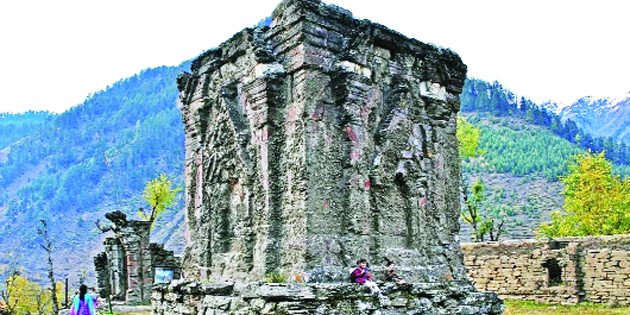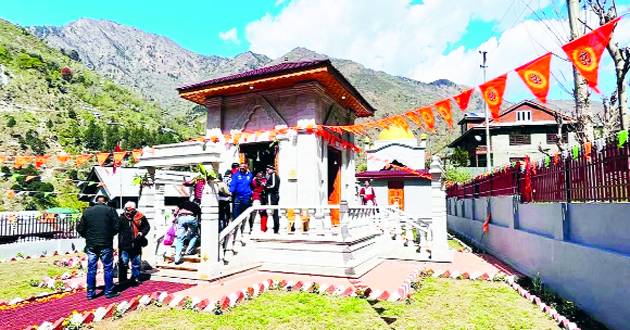‘Teetwal’ Showcasing Hindu culture on the Line of Control

Sharda Temple Old
By Col Satish Singh Lalotra
‘Hinduism is so elastic and subtle that the most profound Methodist and crudest idolator are equally at home with it. ’-George Bernard Shaw’.
The Sub -continent of ours is never bereft of places howsoever remote they may be, kept alive in novels and short stories churned out of world famous chroniclers like ‘Sadat Hassan Manto’ a Pakistani writer, playwright, and author born in Ludhiana; active in British India and later after the partition of India, in Pakistan. ‘Teetwal’ is one such obscure place in Kashmir’s Tangdhar’ made famous by the above mentioned world famous playwright ‘Sadat Hassan Manto’ in his epic story ‘Teetwalkakutta’.
Once renowned as a place brimming with knowledge and commerce, this area has been at the center of some of the bloodiest confrontations between India and Pakistan since 1947. Having endured relentless artillery and small arms bombardment owing to its unique position on the line of control (LOC) for the last 75 years or so, Teetwal has never refused to go into oblivion from both Indian and Pakistani newspapers and media due to its myriad USPs.
The latest USP being Teetwal having cornered the honour of housing and inauguration on 22 March 2023 the famous ‘Shardapeeth temple’ by our Home Minister Amit Shah. This storyline caught my attention and brought me back to the days of December 2003 when while in service I happened to visit this quaint but dangerous place as part of my service assignment at Drugmula coming all the way from Gurez.

Sharda Temple Tweetwal
Hugely restricted to commoners for its strategic- cum – military value ‘Teetwal’ has now crossed the proverbial ‘Rubicon’ when anybody can go up to the banks of R. Kishan Ganga, the de facto border.
The lone exception to the above was made in October 2005 when a temblor of 7. 4 on Richter scale ripped the area around both sides of R. Kishan Ganga but united the hearts and minds of people drawn together by the misery unleashed by the natural calamity.
Credit goes to the revived ceasefire between the rival armies that have given the region enough heft to rebuild their lives. The town of ‘Teetwal’ found its fortunes divided by the vicissitudes of human nature that was unhinged by greed, avarice and narrow sense of nationalism owing to the division of Jammu and Kashmir in 1947-48 Kashmir war.
The trail of death and destruction that it left behind in its wake is still being followed albeit now in a different manner couched in militant acts exported from across the LC. Nestled between the Pakistani side of LC on three sides – Neelum valley to the north and Leepa to the south, Teetwal is remote but not isolated. Its only access is from the 10,000 feet high ‘Sadna Pass’ that overlooks the two sides of the 67 km Kupwara-Teetwal highway.
Perched at an awe-inspiring altitude of 10,200 feet nestled near ‘Teetwal’ lies the mighty ‘Nastha Chun’ pass. Since I was staying for few days at ‘Panzgam’ and had some time on my hands, decided to go ahead as part of area familarisation though it was not out danger to venture on highway during those times.
This write up of mine has been born out of that maverick action when all movements were subject to road opening operations and prior intimation of any vehicular movement.
Nevertheless, the history of ‘Nasthachun’ pass is worth mentioning over here before I tackle the subject proper of ‘Teetwal’sHindu connection per se. ‘Nastha Chun’ when translated directly means ‘Cut nose pass’ a name inspired by the relentless and icy winds that sweep through the region year-round, leaving visitors quite literally numb down the spine. In Kashmiri language it is known as ‘Nathi Chapa Gali’, meaning ‘Numb nose path’ echoing the same chilling experience.
However this mountain pass is more widely known by the name of ‘Sadhnapass’, a name that carries a touch of Bollywood charm and historical significance. ‘SadhnaShivdasni’ popularly known as Sadhna, mesmerized the silver screen during the once vibrant era of Hindi cinema of the 1960s and 70s.
The name gained significance when after the 1965 war, she happened to visit this place and the locals thought in their wisdom to honour her legacy by renaming the pass as ‘Sadhna pass’. Not known to the masses and the young population as such,’Teetwal’ was the base camp for a visit to Shardapeeth’ an ancient Hindu place of knowledge and temple that is located on the other side of the divide.
Shardapeeth, which thrived between the 6th and 12th centuries was renowned for its illustrious library, attracting scholars from diverse backgrounds who travelled great distances to access its precious texts.
The temple annually hosted a pilgrimage, drawing devotees eager to seek the blessings of Ma Sharda. In the 11th century, the Muslim chronicler al-Biruni described it one of the most revered shrines in the Indian sub-continent.
There was a small temple in ‘Teetwal’ where the yatra would start for the site across the river. Surprisingly this small temple had an adjoining gurudawra too which was devastated during the famous ‘Kashmir war’ of 1947-48 according to the caretakers.
The pilgrimage to the temple was a routine till the divide stopped it. For 76 long years, Kashmiri devotees were unable to cross the LOC to reach the site, located approximately 130 kms from Srinagar and a mere 10kms from the LC.
All the above has now been relegated to the past with new innings for the devotees of Ma Sharda ushered in with gusto when on 22 March,2023 the renovated temple was inaugurated by the home minister Amit Shah.
True to the occasion, the HM highlighted the pivotal role this peeth had played in the cultural, religious and educational milieu of India from times immemorial. Prior to the developments, the opening of this track for the pilgrimage of Kashmiri Hindus was discussed at the highest level between India and Pakistan.
On May, another milestone was etched on the firmament of Teetwal when the sikh Gurudwara dedicated to Guru Tegh Bahadur was reopened.
It was the ‘Save Sharda’ committee and Shringeri math’ that were in the forefront of these painstaking efforts towards the resurrection of these twin monuments of historical importance. Both these monuments stand side by side further cementing the intra-cultural bonhomie at as such a place like Teetwal.
As if to preserve the sanctity of the idol that has long been the hallmark of Indian cultural integration it was brought all the way from Shringeri math from the far south and ceremoniously installed amidst the chanting of Vedic hymns by renowned scholars and pundits who had come all the way from Karnataka where the moorti was kept.
This tradition of preserving the precious idols by way of stowing them away from harm’s way has long been the practices of Kings and Maharajas who anticipating the attack by foreign marauders used to first keep their temples of worship safe and then turn their attention towards safeguarding their estates.
The fact that the priests came all the way from Karnataka took my mind back to May 2019 when I had gone to the famous shrine of Badrinath and interacted with the ‘Rawals’ (head priests) over there.
These head priests at Badrinath temple are the famous ‘Namboodri’ brahimns from Kerala. A practice long started in the 8th century by AdiShankaracharya as mark of fostering national integration which we in the present age are struggling to achieve.
The land on which this temple stands was obtained with the support of locals, as it used to house a Dharamshala and a Gurudwara. In fact this whole tract of land starting from Gurez valley all along the Kishan Ganga and later on R. Neelum in Pakistan was the blessed land of Shardapeeth that had its equal only in other equally blessed places like the Nalanda in Bihar and Takshila now in Pakistan.
With such a historic step as taken by the present Modi Government, it now devolves around the UT of Jammu and Kashmir to build allied infrastructure to give the long awaited heft to one of the ShaktIpeeths of this country.
Sitting next to the LOC and watched by our western adversary, Teetwal is a living example of India’s cultural and historical lineage that showcases what a great country India has been despite centuries of foreign domination.
This is truer when seen in the light of the fact that Pakistan a totally theological country has consistently shown a total disregard to its minorities and their places of worship.
I am sure people across R. Neelum on daily basis must be thinking and ruing their fate of casting their destinies with such a nation state that cannot even guarantee a basic right as that of minorities and their places of worship.
(The writer is a retired army officer)




